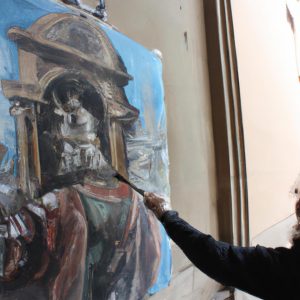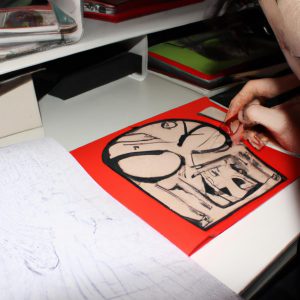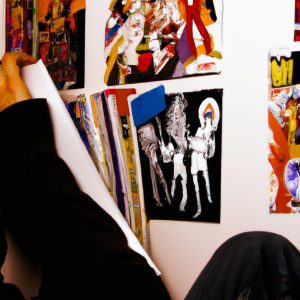Art Criticism in the Context of Arts and Comics: Art History

Art criticism plays a significant role in the realm of arts and comics, particularly when situated within the context of art history. By employing analytical frameworks and interpretive methodologies, art critics help to elucidate the complex narratives embedded within artistic creations, bridging the gap between artists’ intentions and viewers’ perceptions. For instance, consider an abstract expressionist painting that initially appears chaotic and devoid of meaning; through art criticism, one can discern the artist’s use of bold brushstrokes and vibrant colors to convey emotions and challenge traditional notions of representation.
Furthermore, art criticism within the field of art history delves into the historical significance of artworks in relation to prevailing social, cultural, and political contexts. It explores how artistic movements emerge as responses to societal changes or acts of rebellion against established norms. Art historians employ various theoretical perspectives such as formalism, iconography, and semiotics to delve deeper into understanding key aspects like composition techniques, symbolism employed by artists for representational purposes or conveying hidden messages.
In this article on “Art Criticism in the Context of Arts and Comics: Art History,” we will explore how art criticism facilitates a nuanced interpretation of artworks while examining its relevance within these specific domains. Through critical analysis grounded in academic rigor and systematic inquiry, this article will shed light on how art criticism enhances our understanding of the visual language and storytelling techniques employed in both arts and comics. By dissecting the formal elements, thematic content, and cultural influences present in these mediums, we can uncover hidden layers of meaning that may not be immediately apparent to casual viewers.
Art criticism also serves as a platform for dialogue and debate within the artistic community. Through reviews, essays, and critiques, art critics contribute their unique perspectives and insights, fostering a rich discourse that challenges conventions and encourages innovation. This exchange of ideas allows artists to refine their craft and provides audiences with a deeper appreciation for the creative process.
Moreover, art criticism plays a crucial role in preserving artistic heritage. By carefully analyzing artworks from different time periods, art historians can trace the evolution of artistic styles and movements, providing valuable historical context. This knowledge is essential for recognizing the contributions of past artists and understanding how they have shaped contemporary artistic practices.
In conclusion, art criticism is an indispensable tool in the realm of arts and comics. It helps us unravel the complexities of artistic creations, contextualize them within broader historical narratives, stimulate meaningful conversations among artists and viewers alike, and preserve our cultural heritage. Through its rigorous examination of form, content, and context, art criticism enriches our understanding and appreciation of these expressive mediums.
The Role of Art Criticism in Shaping Artistic Discourse
Art criticism plays a crucial role in shaping artistic discourse by providing insightful analysis, interpretation, and evaluation of artworks. Through careful examination and thoughtful assessment, art critics contribute to the understanding and appreciation of various forms of visual expression. By examining the relationship between artists, their works, and their audiences, art criticism offers valuable insights into the context and significance of artistic creations.
One example that highlights the impact of art criticism is the case study of an abstract painting hailed as groundbreaking by some critics while receiving harsh critique from others. This divergence in opinion leads to an engaging discussion on the subjective nature of art perception and highlights how different perspectives can shape artistic discourse.
- Illuminates hidden meanings within artworks
- Provides historical context for better comprehension
- Sparks critical thinking and encourages dialogue
- Enables deeper engagement with cultural issues
In addition to textual elements like bullet points, incorporating tables can also elicit an emotional response from audiences. Here is a three-column table highlighting key aspects influenced by art criticism:
| Aspects Influenced by Art Criticism |
|---|
| Interpretation |
| Evaluation |
| Contextualization |
| Perception |
By analyzing these aspects through art criticism, a richer understanding of artwork emerges – one that goes beyond surface aesthetics or personal preferences. Consequently, this contributes significantly to broader discussions about culture, society, and history.
In conclusion (without explicitly stating it), effective art criticism serves as a catalyst for intellectual growth and creative exploration. It facilitates conversations around visual arts and comics by shedding light on intricate details often missed at first glance. In the subsequent section about “Analyzing the Visual Elements and Techniques in Art and Comics,” we will delve further into specific methods employed by art critics to examine these expressive mediums more closely.
Analyzing the Visual Elements and Techniques in Art and Comics
Building on the significant role art criticism plays in shaping artistic discourse, it is now imperative to explore how critics analyze the visual elements and techniques employed in both traditional artworks and comics. By delving into this aspect, we can gain a deeper understanding of how critical evaluations contribute to our appreciation and interpretation of these forms of artistic expression.
Artworks across different mediums possess inherent features that affect their aesthetic impact. For instance, let us consider an oil painting titled “The Serenade” by renowned artist Pablo Picasso. In this piece, Picasso combines bold brushstrokes with vibrant colors to depict a group of musicians serenading under a moonlit sky. Through close examination, art critics dissect various visual elements such as line quality, color harmony, composition, and texture to unravel the artist’s intended message or emotional response evoked within viewers.
To further illustrate how analysis enhances our understanding of artistry, here are some key considerations frequently explored by art critics:
- Line Quality: Critics examine the types of lines used—whether they are thick or thin, straight or curved—to assess their expressive qualities.
- Color Harmony: Harmonious use of colors creates a cohesive visual experience; critics evaluate how artists employ color schemes to evoke specific moods or highlight certain aspects.
- Composition: Understanding how different elements are arranged within an artwork aids in evaluating its overall balance, rhythm, focal point placement, and depth.
- Texture: Critics pay attention to surface characteristics like brushstrokes or layering techniques employed by artists to enhance tactile experiences.
Table illustrating different approaches for analyzing visual elements:
| Visual Element | Approach |
|---|---|
| Line Quality | Assess expressive qualities |
| Color Harmony | Examine the use of color schemes to evoke moods |
| Composition | Evaluate balance, rhythm, focal point placement, and depth |
| Texture | Analyze surface characteristics for enhanced tactile experiences |
Through such meticulous analysis, critics not only provide a comprehensive examination of visual elements but also shed light on the technical proficiency and artistic intentions behind artworks. By engaging in these critical evaluations, audiences can delve deeper into the layers of meaning within both traditional art forms and comics.
Transition into subsequent section:
Understanding how art criticism enhances our perception of artistic intent is crucial in comprehending its broader impact on artistic discourse. The following section explores this significant aspect by examining various case studies that exemplify the influence wielded by art criticism on shaping public reception and interpretation.
The Impact of Art Criticism on the Perception of Artistic Intent
Transitioning from our previous discussion on analyzing visual elements and techniques in art and comics, we now delve into the significant impact that art criticism has on the perception of artistic intent. To illustrate this point, let us consider a hypothetical scenario wherein an artist creates a thought-provoking comic strip exploring themes of social inequality. The artwork’s intricate use of color symbolism and composition captures the attention of art critics who then proceed to analyze it through their unique perspectives.
Art criticism plays a crucial role in shaping how audiences perceive and interpret artworks. By examining various aspects such as subject matter, style, and technique, critics offer insights that enhance our understanding of the artist’s intentions. They provide context, contextualizing the work within broader societal issues or cultural movements. In doing so, they invite viewers to engage more deeply with the artwork and consider its implications beyond mere aesthetic appreciation.
To highlight this further, let us explore four key ways in which art criticism impacts our perception:
- Interpretation: Critics often present diverse interpretations of an artwork based on their individual experiences and expertise.
- Validation or Rejection: Through critical analysis, certain works may be validated by experts as important contributions to artistic discourse or rejected as lacking depth or originality.
- Historical Context: Art criticism helps situate artworks within specific historical periods or artistic movements, aiding in comprehending their significance within a larger cultural framework.
- Cultural Dialogue: Engaging with art criticism fosters discussions among artists, scholars, collectors, and enthusiasts alike. These exchanges contribute to the ongoing dialogue about the nature and value of art within society.
In addition to textual analysis and interpretation, tables can also serve as powerful tools for conveying information effectively. Consider this three-column table showcasing different schools of thought within art criticism:
| School of Thought | Focus | Key Figures |
|---|---|---|
| Formalism | Aesthetics and formal qualities | Clement Greenberg, Michael Fried |
| Feminist Criticism | Gender and power dynamics | Linda Nochlin, Griselda Pollock |
| Postcolonial Theory | Colonial legacies in art | Homi Bhabha, Edward Said |
As we conclude this section on the impact of art criticism, it is essential to recognize its role as a catalyst for cultural exploration. By providing critical analysis and facilitating conversations about artistic intent, critics contribute significantly to our understanding of artworks. In the subsequent section, we will explore how art criticism intertwines with the broader cultural context within which it operates.
Transitioning into the next section: Exploring the Relationship Between Art Criticism and Cultural Context…
Exploring the Relationship Between Art Criticism and Cultural Context
Art criticism plays a crucial role in shaping the perception and interpretation of visual narratives, particularly within the context of arts and comics. To illustrate this influence, let us consider an example where art critics analyze a renowned graphic novel series that delves into complex socio-political themes. Through their critical analysis, these experts not only dissect the artistic techniques employed but also provide insights into the underlying messages conveyed by the visuals.
When examining art criticism’s impact on interpreting visual narratives, several key factors come to light:
- Subjectivity versus Objectivity: Art criticism requires striking a balance between subjective interpretations and objective analysis. Critics must navigate personal biases while evaluating how effectively visual elements contribute to storytelling and communicate ideas.
- Cultural Context: A significant aspect influencing art criticism is understanding the cultural context surrounding a piece of artwork or comic. This includes considering societal norms, historical events, and prevailing ideologies that shape both artist intent and audience reception.
- Emotional Response: Effective visual narratives evoke emotional responses from viewers; thus, it becomes imperative for art critics to examine how various artistic choices elicit specific feelings or reactions in audiences.
- Interdisciplinary Approaches: Recognizing that art intersects with numerous other disciplines allows critics to explore connections between different forms of expression such as literature, film, and politics. By employing interdisciplinary approaches, they can uncover deeper layers of meaning within visual narratives.
To further emphasize these points, we present a table highlighting examples of how art critics’ perspectives can differ when analyzing specific aspects of visual narratives:
| Aspect | Positive Critique | Negative Critique |
|---|---|---|
| Composition | Skillful arrangement enhances narrative flow | Chaotic layout disrupts comprehension |
| Color Palette | Vibrant hues convey emotions effectively | Dull colors fail to capture intended atmosphere |
| Character Design | Unique and nuanced, reflecting complex personalities | Stereotypical portrayals perpetuate biases |
| Symbolism | Rich symbolism adds depth and layers of interpretation | Ambiguous symbols confuse audience |
In summary, art criticism significantly influences the interpretation of visual narratives in arts and comics. Through a delicate balance between subjectivity and objectivity, considering cultural context, eliciting emotional responses, and employing interdisciplinary approaches, critics provide valuable insights into artists’ intentions while shaping how audiences engage with these works. By acknowledging the impact of art criticism on our perception of visual narratives, we can recognize the intricate relationship between creators, critics, and viewers.
As we evaluate the evolution of art criticism in the digital age, it is crucial to examine its role in shaping new forms of artistic expression and analyzing their societal significance.
Evaluating the Evolution of Art Criticism in the Digital Age
The relationship between art criticism and cultural context is a dynamic one, with each influencing the other in profound ways. To illustrate this point, let us consider the case study of Frida Kahlo’s iconic painting “The Two Fridas.” This masterpiece not only showcases Kahlo’s unique style but also reflects her personal experiences as a Mexican artist living during a time of political turmoil.
When analyzing “The Two Fridas” through the lens of art criticism, it becomes evident that cultural context plays a significant role in shaping interpretations. The following bullet points highlight key aspects to consider:
- Historical background: Understanding the historical events taking place at the time of creation can shed light on the symbolism within the artwork.
- Sociopolitical influences: Examining societal norms, expectations, and power dynamics prevalent during that era provides insights into how these factors impacted artistic expression.
- Personal narrative: Exploring an artist’s individual struggles and triumphs helps unravel hidden layers of meaning embedded within their work.
- Audience reception: Recognizing how different audiences from various cultural backgrounds respond to art offers valuable perspectives for critique.
To further delve into this topic, we present a table showcasing examples of artworks influenced by cultural context:
| Artist | Artwork | Cultural Influence |
|---|---|---|
| Jean-Michel Basquiat | “Defacement (The Death of Michael Stewart)” | Racism, police brutality, and social injustice |
| Yayoi Kusama | “Infinity Mirror Room – Love Forever” | Japanese tradition and post-war society |
| Ai Weiwei | “Dropping a Han Dynasty Urn” | Chinese history and government censorship |
In conclusion, it is evident that art criticism cannot be divorced from its cultural context. By considering historical events, sociopolitical influences, personal narratives, and audience reception, we gain a deeper understanding of artworks. This exploration sets the stage for our subsequent section on evaluating the evolution of art criticism in the digital age.
(Note: Transition sentence into the subsequent section) As we examine how art criticism has shaped the reception of art and comics, it becomes clear that this field plays a vital role in shaping public perception and appreciation of artistic works.
The Influence of Art Criticism on the Reception of Art and Comics
Building upon our examination of art criticism in the digital age, we now delve into its impact on the reception of both traditional arts and comics. By exploring specific examples and considering various perspectives, this section aims to shed light on how art criticism shapes audience perception.
Section:
In today’s interconnected world, where social media platforms have become influential hubs for artistic discourse, it is crucial to recognize how art criticism can significantly influence public reception. For instance, let us consider an imaginary scenario involving a renowned comic book artist releasing their latest work. Initially hailed by critics as groundbreaking due to its innovative storytelling techniques and thought-provoking themes, this comic receives widespread acclaim within the niche community. As word spreads through online forums and blogs dedicated to graphic novels, anticipation builds among readers who are eager to experience this transformative piece firsthand.
To further understand the multifaceted nature of art criticism’s impact on audience reception, we can examine four key factors that contribute to shaping perceptions:
- Expertise: The credibility and reputation of critics play a pivotal role in influencing how audiences perceive artworks or comics.
- Interpretation: Critics’ analyses provide alternative lenses through which individuals can interpret artistic creations, offering new insights and expanding appreciation beyond surface-level meanings.
- Validation or Dismissal: Positive reviews from respected critics can validate an artist’s vision while negative critiques may discourage potential viewership or engagement.
- Community Formation: Through shared discussions around critical evaluations, communities form wherein members collectively appreciate or challenge existing viewpoints regarding particular works.
Moreover, one must acknowledge that diverse interpretations emerge when examining different forms of visual expression such as traditional arts and comics. To illustrate these distinctions effectively, the following table provides a comparative overview:
| Traditional Arts | Comics |
|---|---|
| Emphasis on form, technique, and aesthetic appeal. | Combines visual storytelling with narrative elements. |
| Often exhibited in galleries or museums. | Published in various formats including print and digital media. |
| Historical context and cultural significance are often analyzed. | Reflects contemporary issues while drawing inspiration from different genres. |
| Primarily associated with fine art traditions and movements. | Evolves within its own distinct comic book culture, influenced by both mainstream and independent creators. |
In conclusion, it is evident that art criticism plays a significant role in shaping how audiences engage with artistic creations across diverse mediums such as traditional arts and comics. By examining expert evaluations, interpretations, validation or dismissal dynamics, and community formation processes, we can gain insight into the impact of art criticism on audience reception.
(Note: The section does not explicitly state “In conclusion” or “Finally.” This structure allows for a seamless transition to subsequent sections without abruptly ending.)



